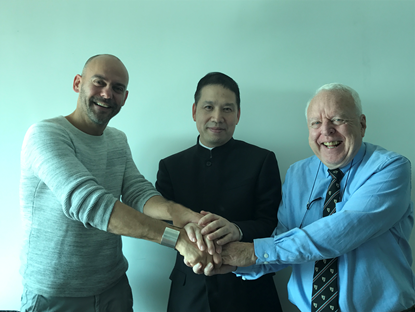“There are various valuable lessons we can learn from the conference”, said Dr. Zhou Jinfeng, the Secretary-General of China Biodiversity Conservation and Green Development Foundation (CBCGDF), during a discussion meeting after his trip from the 13th Conference of the International Convention on Wetlands (Ramsar CoP13) held in Dubai this October. At the discussion meeting, Dr. Zhou shared with CBCGDF members an interesting interlude between him and a Pakistan shuttle bus driver in Dubai, which is a short yet inspiring story that enlightens people upon the perpetual confusion in human history about the art of bringing different hearts together.
It is a simple story: Dr. Zhou came across a Pakistan shuttle bus driver in Dubai, who insisted on driving Dr. Zhou to his destination place even if it meant a round trip and the purpose of this trip was merely to pick up some stuff left behind in the hotel earlier that day. But what’s beyond the story is well worth relishing. That is, it has been widely noticed that our achievement in improving living standard and life quality these days has done little to enhance the bond between people with diverse cultural background, religious beliefs and social status; rather, the interpersonal communication and association seem to be increasingly callous and alienated. The success of Dr. Zhou in enabling the Pakistan driver to voluntarily bear the trouble of a time-consuming round trip lies in the constant sincerity and respect he showed to the driver during their brief interaction, just as the Pakistan driver expressed wholeheartedly later that “we Pakistanis and Chinese are best friends!”
Then why is the story important? It is because whether the idea of “the Ecological Belt and Road Initiative” (EBRs), proposed by CBCGDF based on the “Belt and Road Initiative”, can be eventually practiced for the good of ecological balance and green development depends crucially on concerted efforts from all member countries along the road. Being a leading non-profitable government organization advocating biodiversity conservation and green development, CBCGDF has already foreseen the potential environmental hazards that can be brought to the ecosystem with the burgeoning of infrastructural investment as a core of the Belt and Road initiative. For instance, at the forthcoming side events “The WCPA Areas of Connectivity Conservation” and “Dialogue on Making Likeminded Megadiversity Countries Conservation Leaders for the Ecological Belt and Road Initiatives” to be held on November 19, 2018 and November 21, 2018 in Egypt, respectively, CBCGDF will bring together diverse constituencies to increase understanding and dialogue for building collaborative efforts that lead to inclusion and implementation of Areas of Connectivity Conservation in the Post-2020 Biodiversity Framework, and also discuss international best practices aimed to mitigate new and and grave environmental threats to all of Asia and beyond after the implementation of “the Belt and Road Initiative”. However, it should still be reminded that the outcome of proposing and discussing ideas and designs, no matter how grand and far-sighting they may be, may remain futile without due support and effort from all involved parties to carry them out.
CBCGDF has a tight bond with international colleagues working together, because by staying truthfulness and being authentic, there is no boundaries for worldwide joint efforts toward biodiversity conservation and environmental protection.

Left to right: Nicholas from OceanCare, Dr. Zhou, Prof. Dubee, advisor to CBCGDF. (Photo: CBCGDF)
Composed by / Lei Modified by / Niu Jingmei
